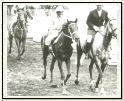Major David Stark Durie, age 36, arrived in New Zealand aboard the Adelaide, the largest of the first five ships that brought emigrants from London to early Wellington in 1840. Some of his fellow cabin passengers (vs. steerage) were officers of the New Zealand Company; Durie himself had served at the British colony of Gibraltar in the 1830s. In 1846, as skirmishes between an increasing number of Wellington area settlers and Maori residents escalated, Governor Grey brought in military regiments. He also established a police force of 50 armed men, appointing Durie as the police inspector (commander), and small ten-man companies of police were sent to various outposts at Hutt, Porirua and Ohariu to assist in maintaining order. Durie took part in actions --including the regular military and local militias -- that captured the Maori Te Rauparaha and other minor chiefs that had been marauding and attacking settlements in protest over land disputes. In 1847 he was based at a newly built police station at Waikanae, to protect construction of the Porirua-Wairarapa Road, where arrested Maoris were interred prior to shipment to Porirua and Wellington for trial. Durie was later appointed the Resident Magistrate for the Wanganui district, where he was living when he bred the earliest members of the Bella family.
Bella was a purebred "high class" arabian mare Durie imported into New Zealand from New South Wales. He bred her to St. Patrick (c. 1850, native-born son of Aether, bred in NSW and imported into New Zealand), dropping a grey filly named Crinoline in 1863. Crinoline produced nine foals, all bred by "J. and C. Durie" (the latter possible Charles Durie, brother to David, who had served in the police). Four of her daughters had offspring recorded in the New Zealand Stud Book: Elsa (1873, by the influential stallion Traducer), Gladiola (1875, by Gladiator), Leita (1876, by Gladiator), and Zip (1879, by Gladiator). The stallion Gladiator was by the great French-bred, English Triple Crown winner Gladiateur; he was bred in England in 1871 and imported to Victoria that year with his dam, Nuncia, and sent to New Zealand in 1872. Crinoline's three recorded sons, Tuna (1874, by Day Dawn), Taipo (1878, by Sator), and Christmas (1883, by Cap-a-Pie), were gelded. Crinoline died in 1886.
Leita produced the gelded Musket (1888, by Armament), for the Duries, winner of the Canterbury Jockey Club's Winter Handicap, and Juanita (1890, by Ascot), who had some foals, and then passed into the hands of S. Morrow, for whom she produced two more foals. Zip bred four recorded offspring, including the gelded Castashore (1892, by Castor), a good stayer of the late 1890s that won the Manawatu Cup, the Timaru Cup, and the Taranaki Cup.
Elsa was a good race horse, with recorded wins in the ARC Easter Handicap Stakes and the ARC Handicap (14 furlongs) in 1878. It was through her daughter, Lady Sarah (1880, by Aerolite), bred by longtime Auckland sportsman Owen McGee, that the family continued. The good runner Bardall (1965, see below) descended from her, as did Halfmarks (1987, by Markella), winner of the 1991 New Zealand St. Leger, and later the Perak Derby and the Singapore Raffles Cup; Halfmark's half-sibling Smart Offer was a versatile racehorse that won some handicaps and in Australia a number of hurdle races. This family branch has had descendants born as late as the 1990s, but it has always been a very slender thread.
|

|
| Bardall
|
|
|
Bardall ch.c. 1965
(Ayrshire Bard - Jane Filou)
Bardall was purchased as a yearling at the Waikato sales by Ivan Robinson of Matangi, who for some years was New Zealand's most succcessful owner-trainer. During his four seasons he started 54 times, winning 19 races, and placing second six times. In 1968-69 Bardall's wins were the Cambridge Breeders' Plate (6 furlongs), the Great Northern Guineas (1 mile), the Waikato Guineas (10 furlongs) and the Great Northern Derby (1-1/2 miles). He was unable to run in the New Zealand Derby due to injury. At the end of the season he was second to the great filly Mayo Gold in the Free Handicap. He went on to star in weight-for-age races in the following seasons, including wins in the PaerRC Queen Elizabeth II Plate three times, the WaikRC Foxbridge Plate twice (then 10 furlongs), the WRC Summer Handicap, the MwtuRC Awapuni Gold Cup, the ARC Mitchelson Cup, the ARC Clifford Plate twice, and the ARC King's Plate, among other races, and was the second leading money-earner in the 1972-73 season. He retired to Tifox Lodge, Matangi, but was not a success at stud.
|
|
Bold=winners of stakes races and important handicap and weight-for-age races
Bella (f) [Arabian]
Crinoline (gr.f. 1863) by St. Patrick
Elsa (gr.f. 1873) by Traducer
| Lady Sarah (blk. f. 1880) by Aerolite
| Lady Clare (br.f. 1899) by Saracen
| Catharina (b.f. 1910) by Soult
| Thurnline (br.f. 1918) by Thurnham
| Queenstown (br.f. 1925) by Archiestown
| | Jay's Jane (b.f. 1941) by Jay
| | Jane Filou (b.f. 1956) by Le Filou
| | Bardall (ch.c. 1965) by Ayrshire Bard
| | Ida Jane (f. 1971) by Idomeneo
| | Katie Jane (f. 1975) by Balkan Knight
| | Halfmarks [The Suntan] (c. 1987) by Markella
| Moss Vale (f. 1930) by Acre
| Hunting Vale (f. 1937) by Hunting Song
| Sing A Song (f. 1946) by Diatomous
| Top Rank (b.c. 1958) by Clarification
Leita (f. 1876)) by Gladiator
| Musket (g. 1888) by Armament
Zip (f. 1879) by Gladiator
Castashore (ch.c. 1892) by Castor
|
|

